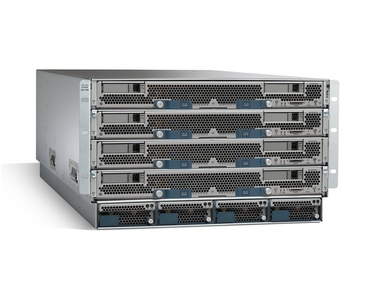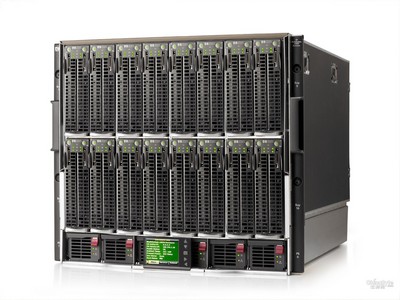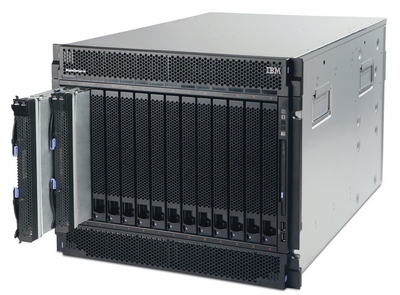HP, IBM, Cisco and Hitachi blade server platforms comparison, part two: network infrastructure, management, server features, service and market share

The second part of the post turned out to be more descriptive, without frontal collisions and tables. The data on the network infrastructure of blade platforms, capabilities and management features, curious features of specific models, service capabilities and market shares of each of the manufacturers presented are brought together.
')
Network infrastructure
Cisco UCS

Cisco UCS has a single network infrastructure with common policies, settings and management. Switching between any physical servers and virtual machines within the system is performed in one logical transition (hop).
A modular distributed switchboard with two root devices and line cards in the chassis and servers is installed on the platform. I / O adapters are virtualized, allowing virtual machines to provide up to 116 independent interfaces. Each of them has its own settings and QoS policies.
In this case, the entire switching factory is configured at the level of profiles and policies with the help of constructions that are tied to server profiles, and not to ports.
Of the infrastructure features, 10G Ethernet unified physical interfaces can also be noted, as well as dynamic bandwidth control between I / O adapters, taking into account the type of traffic and predefined policies.
HP BladeSystem

The network infrastructure in HP BladeSystem relies on the installation of various switches in the chassis, depending on the tasks assigned. Switch manufacturers are HP, Cisco, Brocade, Nortel and other major vendors. The main interfaces are Gigabit Ethernet, 10G Ethernet, 8G FiberChannel and others. In addition, HP is actively promoting its own Virtual Connect interface, mainly among corporate customers building consolidated data centers, in their conditions its advantages are better manifested. Switching at the shelf level is also implemented via Virtual Connect. Server chassis (shelves) interact already through traditional switches.
Dynamic bandwidth control between I / O adapters, taking into account the type of traffic is not carried out, the distribution is set strictly. On most tasks, this facilitates management, albeit by simplifying the configuration as a whole.
To achieve greater flexibility at the chassis level, solutions from Cisco, such as Cisco Fabric Extender for HP BladeSystem, can be used. It enhances visibility, manageability and functionality, both at the virtual machine level and at the level of physical servers.
A key advantage of the HP BladeSystem network infrastructure is the flexibility associated with the ability to use switching from different manufacturers on a wide range of interfaces.
IBM BladeCenter

The IBM BladeCenter platform professes a similar principle: you can install many different switch models in the system, both from IBM itself and from other vendors. The range of interfaces is as wide as possible, and includes both the usual Gigabit Ethernet and 10G Ethernet, as well as the more specific Fiber Channel, SAS and Infiniband.
A large choice of interfaces, on the one hand, increases the flexibility of the platform as a whole, and on the other, it requires additional solutions at the specification specification stage, when careful consideration is required of the advantages of an interface to choose in its favor. At the same time, after making a decision, it will be necessary to adhere to the previously chosen strategy when expanding the functional, because, for example, Brocade network adapters work only with the factory of the same name, and this factory is not “friendly” with Emulex adapters.
You can also find fault with the lack of the possibility of dynamic bandwidth control for various types of traffic and the consequent unavailability of creating a number of I / O interfaces larger than 3 LANs and 1 SAN with fixed bandwidths.
Hitachi Compute Blade 2000

Unfortunately, in the second part of the material Hitachi Compute Blade 2000 is a “dark horse”, because detailed and open information about the network infrastructure of this platform is also not widely available. One could, of course, try to lure the detailed technical specifications of Hitachi, pretending to be some kind of “independent researcher,” but such forgery is not in the style of the author. The Hitachi tactic in such a matter as the availability of information about its decisions is extremely controversial, however, apparently, the responsible persons in the company are not worried about the situation.
From what has been achieved, it becomes clear that mezzanine adapters and PCI form factor adapters can be installed in Hitachi Compute Blade 2000 blade servers. For the former, internal switching can be used with the help of built-in tools, while the latter are deprived of the possibilities of internal switching.
It is important that the switching facilities inside the chassis only work with Gigabit Ethernet and Fiber Channel interfaces. In order to use 10G Ethernet, you will need to install adapters in each server and switch them by external means. This seriously affects the number of cables in a rack, in theory makes it difficult to heat sink and reduces the ease of server migration from the chassis to the chassis.
Hardware Platform Management
Cisco UCS
The platform has a unified management tool called Cisco UCS Manager, it works for the entire server and network infrastructure. It is managed at the level of service profile settings, including BIOS settings, network adapter settings, firmware versions, UUIDs, and others.
The platform allows you to use templates and policies, migrate profiles and replicate mass configurations.
HP BladeSystem
The HP BladeSystem platform implements control at the chassis levels, embedded and aggregating switches, servers. At the same time, "through" settings are made by a separate Insight Control utility that helps automate the configuration process.
The servers inside the chassis can be configured as separate physical servers, which adds convenience in the case of relatively small server in enterprises, or when using the chassis in small private "clouds". With a configuration with dozens of chassis, you need to use proprietary tools for migration and mass deployment of systems, possibly not included in the standard package.
IBM BladeCenter
The organization of infrastructure management in the IBM BladeCenter is similar to that of the HP BladeSystem, where each of the elements of the system can be configured by its own means.
There is an add-in for end-to-end management of the IBM Director, which offers automatic control of firmware, replication of settings, transfer of network identifiers.
Hitachi compute blade
As far as it is possible to draw a conclusion from the available data, platform management solutions are based on external software, in particular, Microsoft System Center. Based on this data, Hitachi Compute Blade offers a basic set of tools for configuring and monitoring all components of the platform, including the chassis itself, switches and servers.
Distinguishing features of servers
Each of the manufacturers of the platforms included in the comparison offers several different server versions, so their direct comparison will be at least incorrect.
In this section, I will highlight the useful features inherent in each of the vendors rather than the specific model.
Cisco UCS
One of the main trump cards of the platform is a virtualized I / O adapter. With it, you can assign up to 116 I / O interfaces to virtual machines that are connected to the corresponding ports on the fabric switch.
HP BladeSystem
Here, an important function that is still relevant today after the release of the eighth generation of the line (Gen 8) is the ability to install up to 64 memory modules in double-sized servers with four processors.
IBM BladeCenter
A distinctive feature of the platform is the technology of dividing one 4-processor HX5 server into 2 dual-processor ones called FlexNode Partitioning. The architecture of the 4-processor IBM HX5 servers is such that physically they consist of two 2-processor servers. Such a decision could theoretically be useful where the division of resources by means of virtualization is not suitable for one reason or another.
Hitachi computeblade
And on this platform, the solution is implemented the other way round: with the help of a hardware adapter, two-processor servers can be combined into a 4-processor system, and four-processor servers into an 8-processor one. This can be useful in the case when, having at its disposal the chassis, the customer increases the capacity of the servers installed in it gradually.
Hitachi also has a curious technology called LPAR, which allows the separation of servers into 16 logical partitions without loss of performance. By its functionality, the technology intersects with the usual means of virtualization, however, theoretically, it can be useful in some applications.
Market position and service
Cisco blade solutions were introduced to the Russian market at the beginning of 2010 and are still a relatively new and unusual product today. In the global market, the share of Cisco blades is about 11%, in the USA it is slightly higher. Accurate data on Russia is not yet available, but it is unlikely that Cisco has managed to reach at least 5% here in a short time - the positions of long-time leaders of HP and IBM are traditionally strong.
HP in the world occupies a good half (about 50%) of the market, and in Russia even more (we are talking about the blade platform market). Despite the fact that the company introduced its modern C-Class platform a few years later than IBM, in the spring of 2006, it managed to quickly take the lead. The company still continues to increase sales.
IBM's position is slightly less stable, mainly due to its market share, increasing its share of Cisco. The global share of IBM blades in the market is about 20%.
Hitachi has extensive experience in supplying equipment to the domestic Japanese market, including the BladeSymphony 2000 platform, sold in the world under the Compute Blade 2000 brand. At the end of 2011, its share in the world was about 1%. Little by little, sales of the company in monetary terms are growing, but a change in market share at such low scales is simply not taken into account.
In terms of service, the “big three” HP, IBM and Cisco have a long-established partner network, and also maintain their products independently throughout the country. At Hitachi, the picture is not so rosy, it makes no sense to invest in the company's service departments.
Conclusion
The final material turned out to be rather not comparative, but survey. Having considered the four platforms, you cannot choose a winner, because the final choice is always on the side of the customer. Perhaps the material will help to lay down in my head a picture of the balance of power between the four vendors, the products of which the market, in the end, is not limited. After all, there is at least DELL, Fujitsu, Huawei and even T-Systems!
On the HP side, there are many years of experience and a large number of engineers who are familiar with the equipment. The technological cycle of the C-Class platform is not yet complete, it has several more successful years ahead.
The history of the IBM BladeCenter is closer to the end, but the company as a whole has a traditionally strong relationship with the public sector.
The Cisco solution is a technological attacker, but the company is still quite far from the actual weight of the number of installations in Russia.
Well, the Hitachi platform is the same “dark horse”, without which it would be simply uninteresting.
By a combination of factors in the overall standings, the platform from HP is expectedly leading, the IBM solution is gradually being supplanted, which gives some chance to Cisco.
Continued. Start is here
Source: https://habr.com/ru/post/145219/
All Articles